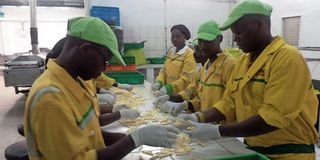Curbing Covid-19 spread at food processing plants

Workers sort potatoes for making chips at Panagro Ltd in Industrial Area Nairobi. Labour is one of the most important aspects for all food-sector players. Infected employees mean reduced productivity and rejection of products for fear of contamination. PHOTO | FILE | NATION MEDIA GROUP
What you need to know:
- Demand for food has risen during the Covid-19 pandemic, highlighting the importance of producers and processors.
- It is important that food supply is less destabilised. Stakeholders in the food sector, from farmers to processors, have an important role to play.
- Ensuring safety of the staff, therefore, should be a primary concern for food producers, transporters, processors, traders and distributors.
- Manufacturers should ensure elimination of any possible threat by keeping the production area as safe as possible.
Demand for food has risen during the Covid-19 pandemic, highlighting the importance of producers and processors.
This means the food sector needs a continuity plan response to stabilise food supply during and after the pandemic.
It is important that food supply is less destabilised. Stakeholders in the food sector, from farmers to processors, have an important role to play.
They, therefore, must work on ways to stabilise the food supply chains even as restrictions to contain the spread of Covid-19 remain in force.
Below is an outline of possible responses to the pandemic by food processors to ensure continuity of supply and to curb the spread of the disease.
Employee safety
Labour is one of the most important aspects for all food-sector players. Infected employees mean reduced productivity and rejection of products for fear of contamination.
Even worse, price surges are possible in food scarcity periods. Ensuring safety of the staff, therefore, should be a primary concern for food producers, transporters, processors, traders and distributors.
For large-scale operators, observe the following:
• Ensure workers follow all the basic hygiene practices all through.
• Staff that come into direct contact with food must wear protective suits with, or, full-face head gear to prevent respiratory droplets from reaching food.
• Let your staff take body temperature checks daily on entering the premises.
• Have suspected cases – coughing, difficulty in breathing, headache, fever, body ache – self-quarantine at home for 14 days.
Raw material sourcing
Raw material sourcing poses a relatively big threat to procurement staff. When handling raw materials, avoid contamination. Interaction between employees must be checked to contain spread of the disease. Staff can reduce the risks in the raw material sourcing by:
• Maintaining social distancing from the suppliers, especially at collection points, which should allow adequate spacing.
• Wear protective clothing, including gloves and full-face masks while at work.
• Where necessary – considering the nature of raw materials and the level of interaction between staff and suppliers – full suits could be provided.
Raw material reception and handling
Manufacturers should ensure elimination of any possible threat by keeping the production area as safe as possible. Staff can reduce risks at the raw material reception section by:
• Putting on full-face masks and even full suits where necessary.
• Sanitise all surfaces – including the suppliers’ vehicles – that might come into contact with the reception area. These include doors and raw material containers before offloading.
•Subject raw materials to processes that help eliminate the threat.
In case of milk, pasteurisation of all the produce before chilling and storing will help reduce chances of harbouring the virus within the plant.
Raw material transition to production
Strict measures should be taken between reception and production area so that no threat is transferred to the latter. Measures that should be taken include:
• Creating barriers between raw material reception platforms and production areas.
•Designating different staff for both reception and production area.
•Ensuring production waste is safe before disposal.
Finished product handling and distribution
This is important to reduce the risk of product contamination, before reaching consumers and to help loaders reduce time taken to unload products at different points.
Measures that should be taken at this point include:
• Designing or upgrading food packaging materials – where necessary – to protect products from contamination.
• Working closely with packaging suppliers to ensure sterility of the packaging materials.
•Products being delivered at specific points should be predetermined and packaged as one. This eases the delivery process and at the same time reduces product handling at offloading points.
• Producers should work with retailers to create offloading areas that are safe from pollution instead of just leaving products in front of the retail shops.
The writer is based at the Department of Dairy and Food Science and Technology, Egerton University.




